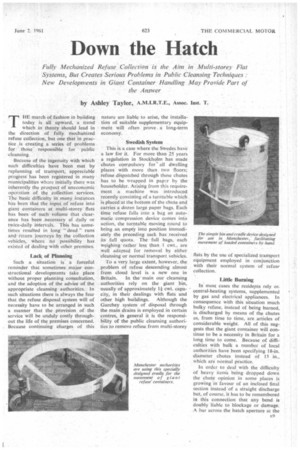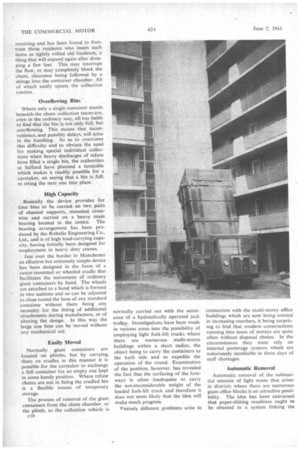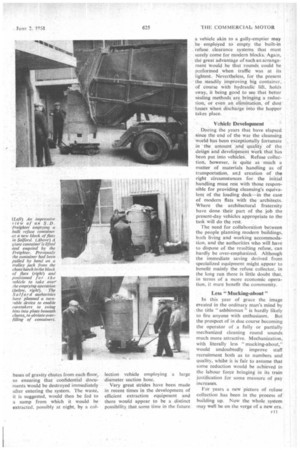Down the Hatch
Page 85

Page 86

Page 87

If you've noticed an error in this article please click here to report it so we can fix it.
Fully Mechanized Refuse Collection is the Aim in Multi-storey Flat Systems, But Creates Serio-us Problems in Public Cleansing Techniques : New Developments in Giant Container Handling May Provide Part of the Answer by Ashley Taylor, A.M.I.R.T.E., Assoc. Inst. T.
THE march of fashion in building today is all upward, a trend which in theory should lead in the direction of fully mechanized refuse collection, but one that in practice is creating a series of problems for those responsible for ' public cleansing.
Because of the ingenuity with which such difficulties have been met by replanning of transport, appreciable progress has been registered in many municipalities where initially there was inherently the prospect of uneconomic operation of the collection services. The basic difficulty in many instances has been that the input of refuse into giant containers at multi-storey flats has been of such volume that clearance has been .necessary af daily or twice-daily intervals. This has some times resulted in long "dead " runs and return journeys by the collection vehicles, where no possibility has existed of dealing with other premises.
Lack of Planning
Such a situation is a forceful reminder that sometimes major constructional developments take place without proper planning consultation, and the adoption of the advice of the appropriate cleansing authorities. In such situations there is always the fear that the refuse disposal system will of necessity have to be arranged in such a manner that the provision of the service will be unduly costly throughout the life of the premises concerned. Because continuing charges of this nature are liable to arise, the installation of suitable supplementary equipment will often prove a long-term economy.
Swedish System
This is a case where the Swedes have a law for it. For more than 25 years a regulation in Stockholm has made chutes compulsory for' all dwelling places with more than two floors; refuse dispatched through these chutes has to be wrapped in paper by the householder. Arising from this requirement a machine was introduced recently consisting of a turntable which is placed at the bottom of the chute and carries a dozen large paper bags. Each time refuse falls into a bag an automatic compression device comes into action, the turntable moving round to bring an empty into position immediately the preceding sack has received its full quota. The full bags, each weighing rather less than 1 cwt., are well adapted for removal by either cleansing or normal transport vehicles.
To a very, large extent, however, the problem of refuse descending almost from cloud level is a new one in Britain. In the' main our cleansing authorities rely on the giant bin, usually of approximately 1+ cwt. capacity, in their dealings with flats and other high buildings. Although the Garchey system of disposal through the main drains is employed in certain centres, in general it is the responsibility of the public cleansing authorities to remove refuse from multi-storey fiats by the use of specialized transport equipment employed in conjunction with their normal system of refuse collection.
Little Burning In most cases the residepts rely on central-heating systems, supplemented by gas and electrical appliances. In consequence with this situation much bulky refuse, instead of being burned, is discharged by means of the chutes as, from time to time, are articles of considerable weight. All of this suggests that the giant container will continue to be a necessity in Britain for a long time to come. Because of difficulties with bulk a number of local authorities have been specifying I8-in. diameter chutes instead of 15 in., which are normal practice.
In order to .deal with the difficulty of heavy items being dropped down the chute opinion in some places is growing in favour of an inclined final section instead of a straight discharge but, of course, it has to be remembered in this connection that any bend is doubly liable to blockage or damage. A bar across the hatch aperture at the
receiving end has been found to frustrate those residents who insert such items as tightly rolled old linoleum, a thing that will expand again after dropping a few feet. This may interrupt the flow, or may completely block the chute, clearance being followed by a deluge into the container chamber. All of which easily upsets the collection routine.
Overflowing Bins Where only a single container stands beneath the chute, collection teams are, even in the ordinary way, all too liable to find that the bin is not only full, but overflowing. This means that inconvenience, and possibly delays, will arise in the handling. So as to overcome this difficulty and to obviate the need for making special individual collections when heavy discharges of refuse have filled a single bin, the authorities at Salford have planned a turntable which makes it readily possible for a caretaker, on seeing that a bin is full, to swing the next one into place.
High Capacity
Basically the device provides for four bins to be carried on two pairs of channel supports, mounted crosswise and carried on a heavy main bearing located in the centre. The bearing arrangement has been produced by the Roballo Engineering Co., Ltd., and is of high load-carrying capacity, having initially been designed for employment in heavy duty cranes.
Just over the border in Manchester an effective but extremely simple device has been designed in the form of a castor-mounted or wheeled cradle that facilitates the movement of ordinary giant containers by hand. The wheels are attached to a band which is formed in two sections and so can be adjusted to close round the base of any standard container without there being any necessity for the fitting of additional attachments during manufacture, or of altering the design. In this way the large size bins can be moved without any mechanical aid.
Easily Moved
Normally giant containers are located on plinths. but by carrying them on cradles in this manner it is possible for the caretaker to exchange a full container for an empty one kept in some handy position. Where refuse chutes are not in being the cradled bin is a flexible means of temporary storage.
The process of removal of the giant containers from the chute chamber, or the plinth, to the collection vehicle is El 0 normally carried out with the assistance of a hydraulically operated jack trolley. Investigations have been made in various areas into the possibility of employing light fork-lift trucks where there are numerous multi-storey buildings within a short radius, the object being to carry the containers to the kerb side and so expedite the operation of the round. Examination of the position, however, has revealed the fact that the surfacing of the footways is often inadequate to carry the not-inconsiderable weight of the loaded fork-lift truck and therefore it does not seem likely that the idea will make much progress.
Fntirely different problems arise in connection with the multi-storey office buildings which are now being erected in increasing numbers, it being surprising to find that modern constructions running into teens of storeys are quite often without disposal chutes. In the circumstances they must rely on internal porterage systems which are notoriously unreliable in these days of staff shortages.
Automatic Removal
Automatic removal of the substantial amount of light waste that arises in districts where there are numerous giant office blocks is an attractive possibility. The idea has been canvassed that paper-slitting machines ought to be situated in a system linking the bases of gravity chutes from each floor, so ensuring that confidential documents would be destroyed immediately after entering the system. The waste, it is suggested, would then be fed to a sump from which it would be extracted, possibly at night, by a col lection vehicle employing a large diameter suction hose.
Very great strides have been made in recent times in the development of efficient extraction equipment and there would appear to be a distinct possibility that some time in the future
a vehicle akin to a gully-emptier may be employed to empty the built-in refuse clearance systems that must surely come for modern blocks. Again, the great advantage of such an arrangement would be that rounds could be performed when traffic was at its lightest. Nevertheless, for the present the steadily improving big container. of course with hydraulic lift, holds sway, it being good to see that better sealing methods are bringing a reduction, or even an elimination, of dust losses when discharge into the hopper takes place.
Vehicle Development
During the years that have elapsed since the end of the war the cleansing world has been exCeptionally fortunate in the amount and quality of the deign and deveropment work that has been put into vehicles. Refuse collection, however, is quite as much a matter of materials handling as of transportation, and creation of the right circumstances for the initial handling must rest with those responsible for providing cleansing's equivalent of the loading deck—in the case of modern flats with the architects. Where the architectural fraternity have done their part of the job the present-day vehicles appropriate to the task will do the rest.
The need for collaboration between the people planning modern buildings. both living and working accommodation, and the authorities who will have to dispose of the resulting refuse, can hardly be over-emphasized. Although the immediate saving derived from specialized equipment might appear to benefit mainly the refuse collector, in the long run there is little doubt that, in terms of a more economic operation, it must benefit the community.
Less "Mucking-about"
in this year of grace the image created in the ordinary man's mind by the title " ashbinman " is hardly likely to fire anyone with enthusiasm. But the prospect of in due course becoming the operator of a fully or partially mechanized cleaning round sounds much more attractive. Mechanization, with literally less " mucking-about," would undoubtedly improve staff recruitment both as to numbers and quality, whilst it is fair to assume that some reduction would be achieved in the labour force bringing in its train justification for some measure of pay increases.
For years a new picture of refuse collection has been in the process of building up. Now the whole system may well be on the verge of a new era.
















































































































































































